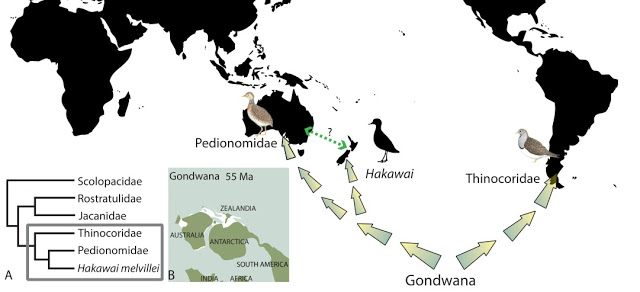
It is commonly known that birds evolved from dinosaurs. But what happened next? Today, shorebirds (otherwise known as waders) live in a wide variety of environments worldwide, from the Himalayas to Antarctica. With their long legs, shorebirds have long been a subject of evolutionary discussion, but where did they originate and how did they diverge into so many habitats across the globe? Due to a poor fossil record, these questions remain largely unanswered. However, a new article published in Journal of Systematic Palaeontology sheds new light on this mystery.
A new piece in this evolutionary puzzle has been presented by an international team of New Zealand and Australian-based scientists, including researchers at Canterbury Museum, who have confirmed that a 19-16 million-year-old shorebird fossil, discovered in Central Otago, New Zealand, belongs to a group of small birds including the Australian Plains-wanderer and the South American Seedsnipes.
The new species, Hakawai melvillei, is named after a ‘mystery bird’ in Māori mythology and in honour of New Zealand-based ornithologist and ecologist David Melville.
Hakawai melvillei was a small wading bird that lived about 19 million years ago during the Miocene epoch, around an ancient subtropical lake on the edge of a floodplain, with many other waterbirds, waterfowl, crocodilians and bats. The finding of individuals at chick or near fledging stage (known from their bone surface texture) shows that Hakawai melvillei was breeding in New Zealand and was not migratory, unlike many birds of this group today.
The closest relative of Hakawai melvillei is the extant Australian Plains-wanderer. These birds are also closely related to the South American Seedsnipes. Hakawai melvillei is extinct, but its ancient lineage and close relationships show how all these birds have a common ancestry in East Gondwana, before the landmass subsequently split up and New Zealand became isolated.
The long legs of the 19 million year old Hakawai melvillei show that it was a wader. The Australian Plains-wanderer and South American Seedsnipes have since independently evolved terrestrial adaptations, but this is evidence that these birds were ancestral waders.
Reference:
Vanesa L. De Pietri, R. Paul Scofield, Alan J. D. Tennyson, Suzanne J. Hand, Trevor H. Worthy. Wading a lost southern connection: Miocene fossils from New Zealand reveal a new lineage of shorebirds (Charadriiformes) linking Gondwanan avifaunas. Journal of Systematic Palaeontology, 2015; 1 DOI: 10.1080/14772019.2015.1087064
Note: The above post is reprinted from materials provided by Taylor & Francis.










